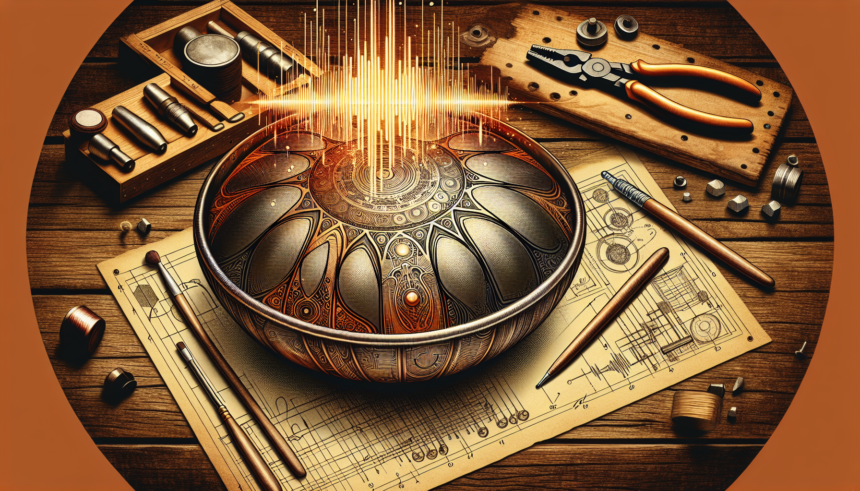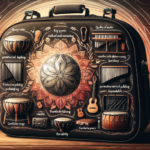Handpans, often lauded for their ethereal tones and unique timbre, have become a staple in modern music for their resonant and meditative qualities. While the untrained ear might chalk up a handpan’s sound to pure magic, those intently familiar with its construction understand that the handpan’s resonance is largely influenced by its material and design. This article delves deep into how these two factors shape the unique sound of handpans and why they are so critical to its musical performance.
A Brief Overview of Handpan Construction
To appreciate the nuances of handpan resonance, it’s essential to understand the basics of its construction. A handpan is built from two metal shells joined together to form a hollow vessel. Typically, these shells are created from nitrided steel, stainless steel, or occasionally non-ferrous metals such as bronze or brass. The top shell features a central note (also called the Ding) and several tone fields arranged in a circular pattern, each of which is meticulously shaped to produce specific notes when struck.
The Importance of Material in Handpan Resonance
The material of the handpan plays a pivotal role in its acoustical properties. Let’s explore some of the most common materials used and their impact on resonance:
Nitrided Steel
Nitrided steel is one of the most common materials used in handpan construction. This metal undergoes a heat treatment process that introduces nitrogen into the surface, making it harder and more resistant to corrosion. The hardening effect not only contributes to the durability of the handpan but also affects its sound characteristics. Nitrided steel typically produces a bright, sustain-rich resonant tone, making it a favorite among many handpan enthusiasts.
Stainless Steel
Stainless steel is another popular choice for handpan makers. Its inherent resistance to rust and oxidation makes it an excellent material for long-lasting instruments. Resonance-wise, stainless steel handpans are known for their warmer, deeper tones. The sustain in stainless steel handpans can be noticeably longer compared to nitrided steel, offering a different palette of sonic textures and richer overtones.
Other Metals
Though less common, some handpans are crafted from non-ferrous metals like bronze or brass. These materials can yield unique tonal qualities, adding variety to the types of sounds handpans can produce. Bronze, for instance, has been noted for its darker, richer timbres, while brass can accentuate brighter, punchier notes.
Design Elements Influencing Handpan Resonance
While material is a fundamental factor, design also plays a crucial role in shaping the resonance of a handpan. The geometry and the precision of tone field tuning significantly impact the instrument’s sound.
Shell Geometry
The curvature and overall shape of the handpan shells directly influence its acoustic properties. A well-designed shell will have a smooth, symmetrically curved surface that ensures even sound distribution and resonance. The depth of the shell affects the volume of air inside the handpan, thereby influencing the resonance and sustain of the notes.
Tone Fields and Dimple Design
Tone fields, including their size, shape, and placement, are meticulously crafted to produce specific notes. The central note or Ding typically sits higher, while the surrounding tone fields are configured lower. The dimple in the center of each tone field is vital for tuning, as it helps focus the vibrational energy and enhance the resonance of the note.
Innovative designs that incorporate deeper or shallower dimples can alter the sustain and decay of sound waves, thus crafting a distinct auditory experience. Some artisans may experiment with unique dimple designs to bring out particular musical characteristics.
Tuning Precision
Hand-tuning the tone fields is arguably the most critical aspect of handpan design. The skilled application of hammers during the tuning process adjusts the pitch and harmonics of each note. This delicate art ensures that the notes are harmoniously aligned and resonate perfectly with one another.
Sculpting and Hammering Techniques
The method employed during the sculpting and hammering phases can also drastically impact the resonance. Each hammer strike alters the tension and thickness of the metal, influencing how it vibrates. Skilled artisans develop techniques that optimize these characteristics, producing a handpan with balanced, resonant tones.
Comparative Analysis: Material vs. Design
While both material and design independently influence handpan resonance, their interplay brings forth the instrument’s full potential. A premium-quality metal can fall short if the design lacks precision, as can a meticulously designed handpan if the material doesn’t complement the structure.
For instance, nitrided steel’s hard character is best accentuated through designs that capitalize on its bright resonance. Conversely, the deep, warm tones of stainless steel require careful attention to sustain and decay properties in the design to fully flourish.
Case Study: The Ideal Handpan
To illustrate, consider a hypothetical “ideal” handpan made from nitrided steel. If the shells are uniformly curved and the tone fields are precisely tuned, the handpan will exhibit bright, sustained notes with rich harmonic overtones. On the other hand, an equally well-designed handpan using stainless steel might offer longer sustain but a warmer, more immersive sound experience.
The Role of Musicians in Handpan Resonance
Interestingly, the way a handpan is played also contributes to its resonance. The force and technique applied when striking the tone fields can change the tonal quality and sustain. A lighter touch might draw out softer, more ambient sounds, while a stronger hit could accentuate the volume and brightness of the notes.
Thus, the material and design provide the foundational characteristics of a handpan, but the player ultimately brings it to life. This interactivity between musician and instrument exemplifies the handpan’s versatility and depth.
Future Trends in Handpan Craftsmanship
Advancements in materials science and design technologies signal a promising future for handpan innovation. Researchers and artisans are continually exploring new metals, composite materials, and innovative design techniques to push the boundaries of what handpans can achieve sonically.
Moreover, integration of digital technology such as 3D printing for shell creation and computer-aided tuning mechanisms may offer unprecedented precision and customization. These advancements promise to further elevate the resonance, timbre, and overall quality of future handpans.
Conclusion
The resonance of a handpan, often perceived as magical, is deeply rooted in the scientific principles of material science and design engineering. The right combination of metal and meticulously crafted design elements results in an instrument with a rich, resonant voice that captivates listeners and players alike. As technology and craftsmanship continue to evolve, the future of handpan soundscapes looks ever more intriguing and expansive.
FAQs
1. What material produces the brightest sound in a handpan?
Nitrided steel is known for producing a bright, sustain-rich resonant tone, often preferred for its durability and vibrant sound quality.
2. How does the shell depth affect handpan resonance?
The depth of the shell affects the internal volume of air, which in turn influences the resonance and sustain. Deeper shells generally produce more profound and sustained notes.
3. Can non-ferrous metals be used to make handpans?
Yes, non-ferrous metals like bronze and brass are sometimes used to make handpans, yielding unique tonal qualities such as darker timbres for bronze and brighter notes for brass.
4. How does the design of tone fields influence sound?
The size, shape, and placement of tone fields significantly impact the pitch, resonance, and harmonic overtones of each note. Properly designed tone fields ensure seamless integration and enhanced overall sound quality.
5. What advancements can we expect in future handpan crafting?
Potential future advancements include the use of new materials, composite innovations, 3D printing for shell creation, and computer-aided tuning mechanisms, all aimed at improving precision and customization.





